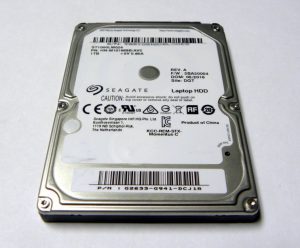
Seagate ST1000LM024 drive.
You’ve just bought a new hard drive — or did you?
On February 8th, Seagate responded to reports that Exos hard drives were being sold with S.M.A.R.T. (Self-Monitoring, Analysis, and Reporting Technology) values reset, effectively making the used hard drives appear as brand-new products.
While Seagate explicitly sells refurbished hard drives as part of its sustainability efforts, those drives are explicitly marketed as “renewed” (and at a significant discount, as compared with brand-new hard drives).
“We take this matter very seriously and are conducting a thorough investigation,” a spokesperson told Forbes. “Seagate did not sell or distribute these drives to resellers.”
“While we cannot share specific details of this ongoing investigation, we suspect these drives were new products that Seagate sold to customers who later sold them on the used market.”
If you’ve purchased a hard drive and you’re concerned that you might have been scammed, here’s what to know.
In most cases, consumers can determine whether hard drives are used by checking S.M.A.R.T. data.
Hard drive S.M.A.R.T. parameters track various details about the drive’s health, including the number of bad sectors (a key indicator of an impending hard drive failure) and a count of the hours that the drive has spent in the powered-on state.
The latter number is expressed as Power-On Hours (POH), and any decent S.M.A.R.T. analysis tool will show POH alongside other parameters. To learn how to check those parameters, read: How to Read Hard Drive S.M.A.R.T Data.
Of course, if S.M.A.R.T. data has been altered — which is what is alleged in the Seagate case — the POH won’t show a high value.
Another drive data log, F.A.R.M, cannot be altered.
F.A.R.M. stands for Field Accessible Reliability Metrics. Comparing the power-on hours reported by F.A.R.M. and S.M.A.R.T. can demonstrate whether or not a hard drive was used.
Github user gamestailer94 has created a convenient, free HDD Farm Check Tool that can be utilized for this purpose.
Note that this F.A.R.M. tool is specific to Seagate drives — it will skip non-Seagate drives. It requires a bit of technical knowledge to run, but gamestailer94 explains those requirements in a helpful Reddit post.
One Reddit user tried the tool, and immediately discovered an issue:
“Looks like my “new” 16TB exos drives from East Digital were used (10,000hrs),” the user wrote, “but at the price I kinda suspected they were.”
If a hard drive deal seems “too good to be true,” it probably is.
The allegedly fraudulent Seagate drives were not sold by official resellers, and we believe that there’s a high probability that they were used in crypto mining operations and other high-runtime, quasi-legal use cases.
Their prices reflected that. If you’re paying $30 for a 2-terabyte hard drive, something’s off — use common sense when purchasing storage media, and you’ve probably got nothing to worry about.
Other general tips:
- Wherever possible, purchase hard drives in-person from reputable retailers or directly from manufacturers.
- In our opinion, it’s wise to avoid sites like Amazon and eBay. We’ve written extensively about fake flash drive and SSD scams from sites like Amazon, and we haven’t seen significant evidence that the retailer is addressing those scams.
- Regardless of where you purchase your hard drives and SSDs, back up your data. Any storage device can fail. While brand-new devices are less likely to fail, you’re still taking a risk if you store data in one location.
If you’ve lost data from a hard drive, SSD, flash drive, or any other device, we’re here to help. Datarecovery.com provides free media evaluations, and thanks to our no data, no charge guarantee, you don’t pay if we’re unable to recover your data.
Call us at 1-800-237-4200 to connect with an expert or click here to submit a case online.




